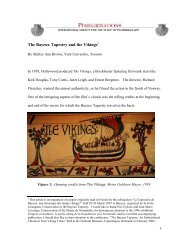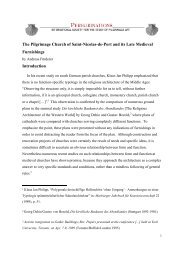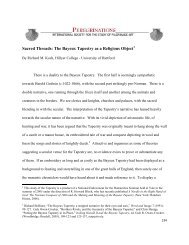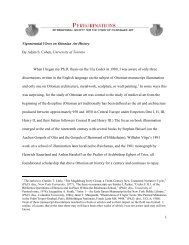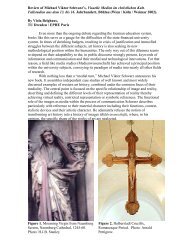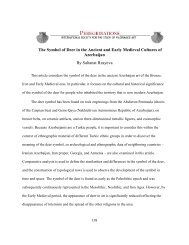Pilgrimage and Faith: Buddhism, Christianity, and ... - Peregrinations
Pilgrimage and Faith: Buddhism, Christianity, and ... - Peregrinations
Pilgrimage and Faith: Buddhism, Christianity, and ... - Peregrinations
You also want an ePaper? Increase the reach of your titles
YUMPU automatically turns print PDFs into web optimized ePapers that Google loves.
<strong>Pilgrimage</strong> <strong>and</strong> <strong>Faith</strong>: <strong>Buddhism</strong>, <strong>Christianity</strong>, <strong>and</strong> Islam<br />
http://www.serindia.com/item.cfm/606 I<br />
Curated by Virginia Raguin <strong>and</strong> Dina Bangdel with F.E. Peters<br />
Funded in part by a grant from the National Endowment for the Arts<br />
For the fully illustrated brochure, click here.<br />
2010-2011<br />
Four venues<br />
First Venue: Iris <strong>and</strong> B. Gerald Cantor Gallery, College of the Holy Cross, Worcester, MA,<br />
Spring 2010 January 27- April 10, 2010<br />
Second Venue: Loyola University Museum of Art, Loyola University, Chicago IL, August 20 –<br />
November 14, 2010.<br />
Third Venue: University of Richmond Museums of Art, January 28 to May 20, 2011<br />
Fourth Venue: Rubin Museum of Art, New York, July 1 - October 24, 2011.<br />
Figure 1a: Hajj; Arafat, 1974. Photo: S. M. Amin /Saudi Aramco World/SAWDIA<br />
Figure 1b: Scala Santa (Holy Stairs) Rome, 2009. Photo: Michel Raguin<br />
Figure 1c: Buddhist festival in Kathm<strong>and</strong>u, Nepal, 2003. Photo: Dina Bangdel
INTRODUCTION<br />
This exhibition focuses on fundamental issues of the three religions <strong>and</strong> the many ways<br />
their practices converge in the pilgrimage experience. The pilgrim’s goal is the holy site; to<br />
approach it involves both physical <strong>and</strong> temporal expense, beginning through detachment from<br />
the familiar. The hoped-for result is the acquisition of humility, acknowledging the smallness of<br />
the self <strong>and</strong> the greatness of the divine. Paramount is the injunction to exercise charity to others<br />
<strong>and</strong> also in humility to accept charity from others.<br />
Although often rare <strong>and</strong> beautiful, art also functions as a vital part of social systems that<br />
cement the bonds of community, as well as supporting the role of religion in transcending human<br />
limitations. All three religions display a deeply felt motivation to affect the life of the believer<br />
through transformative experience, frequently involving art. All structure an intersection of the<br />
individual with both natural <strong>and</strong> built environments, ritualized behavior, <strong>and</strong> tangible objects.<br />
This tangible object may range from a bejeweled statue venerated at a national shrine to the<br />
commonly available chromolithograph. <strong>Pilgrimage</strong> ultimately creates a liminal situation within<br />
which the believer is neither in the realm of the ordinary nor yet within the sacred.<br />
The juxtaposition of religions whose beliefs <strong>and</strong> practices are so often seen as<br />
incompatible reveals profound similarities. Participants on pilgrimages saw objects of supreme<br />
artistic skill (Islamic glazed tile, Christian enameled reliquaries, or Buddhist bronze statues)<br />
mingled with mass-produced objects (lead pilgrimage badges, terracotta souvenirs, or paper<br />
mementos) <strong>and</strong> personal acquisitions such as stones or soil from the holy place. Such objects<br />
make more tangible the ephemeral experience <strong>and</strong> thus enable the owner to intensify memories<br />
of spiritual commitment <strong>and</strong> social interaction. (Figs. 2a <strong>and</strong> 2b)<br />
Figure 2a: Virgin & Child of Kalwaria Zebrzydowska, Prague, 1902. Photo: Michel Raguin<br />
Figure 2b: Clay plaque of Guru Rinpoche (2 ¾ inches), The Newark Museum, Gift of Mr. Leo LeBon 1982,<br />
82.207 F2. Photo: by permission
The practices of Buddhists, Christians, <strong>and</strong> Muslims testify to a desire to believe in the<br />
sacred made more accessible at a holy place. This vital sacred power or blessing is known to<br />
Tibetan Buddhists as chinlab (byin rlabs). Early Christian tombs of saints were seen as<br />
possessing praesentia, the physical presence of the holy. Charity to the pilgrim can be seen as<br />
sharing the sacred power, the holy. For Muslims, charity is one of the Five Pillars of Islam, <strong>and</strong><br />
acts of charity are imbedded in the hajj ritual, with the slaughter of animals whose meat is then<br />
distributed to the poor. In Tibet, Buddhist pilgrims can receive well wishes <strong>and</strong> material help in<br />
the form of food <strong>and</strong> money from many people, including Han Chinese <strong>and</strong> Westerners.<br />
A pilgrim seeks to purify, connecting the inner process with the exterior physicality,<br />
especially ascent <strong>and</strong> circumambulation. Most pilgrimages involve long days of journey across<br />
often arduous terrain. (Figs. 3a <strong>and</strong> 3b) But even with the goal attained, Buddhists<br />
circumambulate many times the sacred objects such as a temple, a stupa or even an entire<br />
monastery; Christians climb the stairs to embrace the statue of St. James in Compostela; <strong>and</strong><br />
Muslims circumambulate the Ka’ba. Pilgrims often wear special dress, such as a white coat in<br />
Japan decorated with stamps from the temples visited, or carry amulets: prayer scrolls rolled<br />
within cylinders worn in Iran, a Tibetan Gau with its small objects of blessing <strong>and</strong> memory, <strong>and</strong><br />
Christian pilgrimage badges. These tangible manifestations of commitment are directed inward<br />
as much as outward. We are fragile beings; our attention wavers <strong>and</strong> our energy fails. Reminders<br />
are necessary, whether attention to scheduled hours of prayer, communal hearing, or recitation of<br />
holy texts, or the wearing of a particular form of dress or adornment, all serve to focus purpose.<br />
Figure 3a <strong>Pilgrimage</strong> on the Camino of Santiago, 2008. Photo: Virginia Raguin<br />
Figure 3b <strong>Pilgrimage</strong> in Tibet from Nyethang to Samye, 2007. Photo: Krisadawan Hongladarom<br />
Buddhist <strong>Pilgrimage</strong><br />
And they, An<strong>and</strong>a, who shall die while they, with believing heart, are journeying on such<br />
pilgrimage, shall be reborn after death, when the body shall dissolve, in the happy realms of<br />
heaven.”<br />
Mahaparinirvana Sutra, Ch.IV, 140.<br />
As the world’s fourth largest religion with more than 350 million followers, <strong>Buddhism</strong>’s<br />
foundational creeds are non-violence (ahimsa) <strong>and</strong> the development of the qualities of loving<br />
kindness (maitri), altruistic compassion (karuna), <strong>and</strong> wisdom (prajna). These basic tenets of<br />
<strong>Buddhism</strong> were taught by its founder Shakyamuni Buddha, who himself was an ordinary mortal,
orn as a prince in 5 th century BCE India who attained enlightenment (bodhi) through rigorous<br />
meditation <strong>and</strong> self-transformation. For Buddhist practitioners, Shakyamuni’s life serves as a<br />
paradigm of this spiritual path, that full awakening is accessible to every living being, <strong>and</strong><br />
enlightenment may be attained anywhere, anytime, through any method, as long as it is<br />
vigorously pursued. Hence, pilgrimage to the sacred places associated with the historical Buddha<br />
Shakyamuni becomes one of the most visible <strong>and</strong> enduring expressions of religious practice<br />
throughout the Buddhist world.<br />
Called tirtha yatra in Sanskrit, ―a journey to the ford/crossing,‖ Buddhist pilgrimage<br />
serves as a means to accrue merit <strong>and</strong> as an act of purifying the physical body through the sacred<br />
journey. (Fig. 4a) The goal of Buddhist pilgrimage then is to profoundly change the practitioner<br />
through the transformative experience, both mental <strong>and</strong> physical. Art supports the ritual of<br />
pilgrimage as the engagement of a journey, the acts of merit-making, charity <strong>and</strong> alms-giving<br />
during the process <strong>and</strong> beyond, sacred viewing at the site, <strong>and</strong> construction of memory through<br />
ephemera.<br />
Figure 4a: Woman with prayer wheel at Jokhang Temple, Lhasa, Tibet, 2006. Photo: Luca Galuzzi - www.galuzzi.it.<br />
Figure 4b: Mahabodhi Temple (19th century), Bodhgaya, India. Photo: Dina Bangdel<br />
From the earliest literary reference as indicate by the quote above, India was the sacred<br />
l<strong>and</strong> for Hinduism, <strong>Buddhism</strong>, <strong>and</strong> Jainism. From as early as the lifetime of Shakyamuni Buddha<br />
(c. 563- 483 BCE), pilgrimage to India, the birthplace of the religion, naturally became the center<br />
of the Buddhist pilgrimage tradition. Sites related to the major events of the Buddha’s life,<br />
known as the Eight Great Sites of Wonder (Astamahapratiharya), lie at the core of all Buddhist<br />
pilgrimage. These include the place of his birth at Lumbini, his enlightenment at Bodhgaya,<br />
India, (Fig. 4b) his first Sermon at Sarnath, <strong>and</strong> his death at Kushinagara <strong>and</strong> the sites associated<br />
with his four great miraculous events. The earliest art of <strong>Buddhism</strong>, from as early as the 1st<br />
century BCE, represents the visual narratives of pilgrimage.<br />
<strong>Pilgrimage</strong> in the Buddhist tradition highlights the centrality of relics <strong>and</strong> their power.<br />
Because being in the presence of a relic <strong>and</strong> taking darsan (―sacred viewing‖) of relics accrues<br />
merit, visiting the sites where relics are found is a principal impetus for pilgrimage in <strong>Buddhism</strong>.
Sites associated with the physical relics (e.g., a tooth, a hair, or ashes from cremation) of the<br />
historical Buddha <strong>and</strong> relics by association (e.g., places made sacred by his presence, or a bowl<br />
or robe used by the Buddha) therefore map the sacred Buddhist l<strong>and</strong>scape of India. A third<br />
category of relics is consecrated paintings or sculptures, which serve as reminders of the sacred<br />
sites. The objects associated with this relic category include not only art works of high artistic<br />
skill <strong>and</strong> materials such as gold, silver, silk or bronze, but also ephemeral objects of paper <strong>and</strong><br />
clay that embody the experience <strong>and</strong> power of pilgrimage for the practitioner.<br />
Buddhist practice has supported the re-creation of surrogate pilgrimage sites. In regions<br />
far from the Buddhist sacred center of India where there was little possibility of visiting the core<br />
sacred sites of <strong>Buddhism</strong>, Indian sacred sites were frequently re-created. This symbolic<br />
reconstruction created surrogate pilgrimage sites <strong>and</strong> produced a localized sacred geography <strong>and</strong><br />
l<strong>and</strong>scape. Many among these are associated with the natural world as the tangible expressions<br />
of the sacred in the natural world. These surrogate sites were often found in beautiful natural<br />
settings in distant places, where the rigors of travel became central to the pilgrimage experience.<br />
The remote Mt. Kailash in northwest Tibet, considered the center of the Buddhist, Hindu, Jain,<br />
<strong>and</strong> Bon world systems, is one such sacred place. (Fig. 4c) Ritual circumambulation around the<br />
base of the 22,000 foot mountain is a merit-making activity that takes four days. Indeed, in Tibet<br />
a Buddhist pilgrim is often described as a person who goes around a sacred place. These<br />
journeys reinforce the conception of the physical l<strong>and</strong>scape as sacred.<br />
Figure 4c: Mount Kailash. Photo: Toni Neubauer<br />
Figure 4d: Avalokiteshvara, the Bodhisattva of Compassion, Tibet, 2nd half of the 13th century. The Newark<br />
Museum, Purchase 1979, The Members’ Fund, 79.442. Photo: by permission
Figure 4e: Japanese Pilgrim’s Robe, 1977, Collection Robert <strong>and</strong> Marilyn Hamburger. Photo: Michel Raguin<br />
<strong>Pilgrimage</strong> sites are fluid; they transform to meet needs of devotees. First, they live in<br />
memory for those who have experienced the physical journey to the site itself. But, in many<br />
cases the original pilgrimage sites are replicated for easier access. The Bodhisattva of<br />
Compassion, Avalokiteshvara, has widespread devotion across Asia. (Fig. 4d) Known in Japan<br />
as Kannon, the Bodhisattva is chiefly honored through a pilgrimage in Saikoku (Western<br />
Provinces) in central Japan that was eventually replicated at some 230 different places in the<br />
country. In the twenty-fifth chapter of the popular sacred text, the Lotus Sutra, Kannon appears<br />
in thirty-three different forms to save all sentient creatures. This Mahayana Buddhist text<br />
presents the powerful concept that multiple emanations of individual deities manifest a unified<br />
spiritual whole. Mahayana thinkers believe in the permanent presence of the Dharma or Buddhist<br />
Law in all spheres of existence, <strong>and</strong> assert that countless Buddhas <strong>and</strong> Bodhisattvas fill the<br />
universe to assist sentient beings in their spiritual quests. Just as the historical Buddha<br />
Shakyamuni presented multiple versions of himself walking, st<strong>and</strong>ing, sitting, <strong>and</strong> lying down<br />
during the miracles at Shravasti in India, so too other deities, like Kannon, present multiple<br />
versions of themselves. The <strong>Pilgrimage</strong> to the Thirty-Three Holy Places of Kannon in the<br />
Western Provinces is a 1500-mile route including clusters of temples in the city of Kyoto, as well<br />
as temples in the remote countryside, by the sea or lakes or in the mountains. Pilgrims begin the<br />
Saikoku <strong>Pilgrimage</strong> at Seigantoji at Nachi on the coast due south of Kyoto. Just as pilgrims<br />
venerating the Eighty-Eight shrines on the isl<strong>and</strong> of Shikoku, they often wear a white coat or a<br />
simple white shirt on which the names of the temples visited can be stamped. (Fig. 4e)
Christian <strong>Pilgrimage</strong><br />
Christians have embraced pilgrimage as an essential search for stability in face of the<br />
ephemera of life. The practice can be seen in relationship to the religion’s central tenet, the<br />
incarnation of Christ. Within a triune God, consisting of the Father, Son, <strong>and</strong> Holy Spirit, the<br />
second person, the Son, is both God <strong>and</strong> Man through his birth from Mary. Consequently, both<br />
the search for the physical trace of God on earth <strong>and</strong> the desire to depict the person of Jesus have<br />
galvanized Christian piety from its origins. Since Christ’s human nature died <strong>and</strong> rose from the<br />
dead, believers see a promise of the resurrection of the dead for all his followers.<br />
Since the earliest evidence of the cult, adherents expressed a desire to be close to the sites<br />
where the God/Man lived. The first object of pilgrimage was therefore the Holy L<strong>and</strong>, to places<br />
such as Bethlehem, (site of birth), the Sea of Galilee (site of preaching) <strong>and</strong> above all Jerusalem<br />
(site of death <strong>and</strong> resurrection). The anonymous pilgrim of Bordeaux wrote around 333 CE,<br />
arriving in the Jerusalem while the construction of the basilica of the church of the Holy<br />
Sepulcher was still in process. These early pilgrims were desirous of returning with a tangible<br />
souvenir of the pilgrimage. Relics for the pilgrim might be a stone from paths where Christ<br />
walked, water from a well, or even a piece of cloth or a statue that touched Christ’s tomb. Later<br />
Christians far from these places often constructed replica sites, as did Buddhists who lived a<br />
great distance from India. Christians created replicas of varying exactitude of the Holy<br />
Sepulcher, (Fig. 5a) such as the Temple Church in London, (Fig. 5b) enabling those who could<br />
not journey to the Holy L<strong>and</strong> to revere in a special way the tangible moment of Christ’s death<br />
<strong>and</strong> earthly resting place before his resurrection.<br />
Figure 5a: Holy Sepulcher; Tomb of Christ, from David Roberts, The Holy L<strong>and</strong>, 1842-1849, John J. Burns Library<br />
at Boston College. Photo: by permission<br />
Figure 5b: Temple Church, London, 1185 <strong>and</strong> 1240. Photo: Michel Raguin
Places of worship grew up over the sites of other holy graves, just as the grave of Christ<br />
was honored. At the same time that he constructed the great church in Jerusalem, the Emperor<br />
Constantine built the basilica of St. Peter over a cemetery believed to contain the grave of the<br />
first pope. The dem<strong>and</strong> to be close to the tangible remains of heroic Christians, great confessors<br />
<strong>and</strong> martyrs, especially in the founding of new churches, encouraged the partition of bodies to<br />
allow the sacred ―aura‖ that facilitated God’s grace to be shared among a growing community.<br />
Churches were founded with relics as their essential talisman <strong>and</strong> stone altars with cavities<br />
inscribed with their list of relics dated from 320, a practice that was later routine. For the<br />
founding of Canterbury in the 5 th -century, according to Bede (673-735), the pope provided<br />
Augustine with ―all the things needful for the worship <strong>and</strong> service of the church, namely, sacred<br />
vessels, altar linen, church ornaments, priestly <strong>and</strong> clerical vestments, relics of the holy Apostles<br />
<strong>and</strong> martyrs <strong>and</strong> also many books‖ (Hist. Eccl., I, xxix).<br />
<strong>Pilgrimage</strong>s continued as a vital aspect of <strong>Christianity</strong> through the centuries. The desire to<br />
honor a revered individual <strong>and</strong> to petition for special grace for oneself or for others provided the<br />
underlying reasons for the routine of pilgrimages. As Chaucer (d.1400) presented so vividly in<br />
the Canterbury Tales, when April comes with its good weather <strong>and</strong> sweet showers cause the bud<br />
to bloom, it simply follows:<br />
Then do folk long to go on pilgrimage,<br />
And palmers to go seeking out strange str<strong>and</strong>s,<br />
To distant shrines well known in sundry l<strong>and</strong>s.<br />
And specially from every shire's end<br />
Of Engl<strong>and</strong> they to Canterbury wend,<br />
The holy blessed martyr there to seek<br />
Who helped them when they lay so ill <strong>and</strong> weak (Prologue: lines 12-18).<br />
Figure 5c: Miracle windows of St. Thomas Becket, 1213-15/20, Canterbury Cathedral. Photo: Virginia Raguin<br />
Figure 5d: St. James, 1166-1188, Cathedral of Santiago de Compostela. Photo: Michel Raguin
It was the rhythm of life, a rhythm deeply imbedded into l<strong>and</strong>scape, architecture, paths,<br />
buildings, statues, <strong>and</strong> images. Throughout the entire Middle Ages, <strong>and</strong> in Catholic Europe<br />
through the Renaissance <strong>and</strong> Baroque eras, the possession of relics of important saints made sites<br />
popular. Such indeed was Canterbury, with its body of a martyred archbishop who had<br />
challenged the authority of the English king. (Fig. 5c) Veneration even included significant<br />
displacement to visit theses relics. The well-known autobiography of English pilgrim Margery<br />
Kempe (c. 1373-1440s), who journeyed to numerous shrines, invariably associates them with<br />
relics, even locally, as at the tomb of St. William of Norwich.<br />
The tomb of the Apostle St. James the Great in Northern Spain was particularly<br />
important. Pilgrims walked hundreds of miles from Germany Switzerl<strong>and</strong> <strong>and</strong> Northern France<br />
across the Pyrenees through northern Spain to reach the site honoring the man who lived <strong>and</strong><br />
worked with Christ. Soon the image of the saint acquired the characteristics of a pilgrim to his<br />
own shrine, carrying a staff for walking, a broad-brimmed hat, long cloak, <strong>and</strong> the symbol of the<br />
pilgrimage, the scallop shell acquired from the sea a short distance from the shrine (Fig. 5d) The<br />
worshipper did not believe that the souls of the saints remained in such relics (body, bone<br />
fragment, or clothes worn), but that these things would act as conduits to grace. They would link<br />
the revered intercessor, the saint favored in the eyes of God, to his or her faithful on earth. Not<br />
only sacred viewing, at the core of Buddhist pilgrimage, but also alms-giving was essential to<br />
Christian practice. The last chapter of the 12 th century Pilgrim’s Guide to Santiago de<br />
Compostela discusses charity to be offered to travelling pilgrims.<br />
Commentators, however, not infrequently questioned the value <strong>and</strong> the validity of the<br />
pilgrimages. Santiago became a rallying cry for the ―reconquest‖ of Spain by Christians <strong>and</strong> the<br />
saint developed into Santiago Matamoros: James the slayer of the Moors. (Fig. 5e) What for one<br />
group may be a means of spiritual detachment <strong>and</strong> also charitable acts along the pilgrimage route<br />
could also become a focal point for xenophobic antagonism towards those who do not share the<br />
belief.<br />
Figure 5e St. James the Moorslayer (Santiago Matamoros), late 18 th century, Cristo Rey Church, Santa Fe, New<br />
Mexico. Photo: Virginia Raguin<br />
Figure 5f Shoes left as ex-votos for the Santo Niño de Atocha, 2006, Santuario de Chimayó, New Mexico. Photo:<br />
Virginia Raguin<br />
Christian pilgrimages are popular today. Holy cities like Jerusalem, with its places<br />
marking the death <strong>and</strong> resurrection of Christ are revered as sites sacred to the origin of the<br />
religion. The road to Santiago still attracts numerous individuals, young <strong>and</strong> old <strong>and</strong> from a
diversity of nations. The motivations are diverse <strong>and</strong> include personal purification, experience of<br />
illness, <strong>and</strong> desire for bonding to a greater <strong>and</strong> more global community. Deeply personal needs<br />
are still expressed. In the New World, places like the Sanctuario of Chimayó in New Mexico<br />
bristle with petitions <strong>and</strong> thank offerings (ex votos) of baby shoes, portraits of children in the<br />
military service, or crutches <strong>and</strong> braces testifying to restored health. (Fig. 5f)<br />
Muslim <strong>Pilgrimage</strong><br />
In the year 610 CE, when he was about forty, Muhammad, a citizen of Mecca, Saudi<br />
Arabia, had a vision which he experienced as a call from God to relay to his townsmen a<br />
message from God (called Allah). For twenty-two years he publicly proclaimed that message in<br />
what he called the Quran, ―The Recitation.‖ What God required was ―submission‖ (islam), to a<br />
belief in a single God, This was troubling news for the great majority of Meccans who wanted no<br />
part in ―The Submission‖ that was Islam. They got rid of their troublesome prophet, who found<br />
asylum in the oasis of Medina, but it was only a temporary respite. In the end, Muhammad<br />
returned in triumph: the Meccans became ―submitters‖ (muslimun).<br />
Every Muslim assumes a fivefold religious obligation. The first is a matter of faith, to<br />
pronounce <strong>and</strong> adhere to the conviction expressed in the Muslim creed, which begins with the<br />
rigorous statement of monotheism, ―There is no god but the God,‖ <strong>and</strong> ends with the specifically<br />
Muslim affirmation, ―... <strong>and</strong> Muhammad is the Envoy of God.‖ There follow four prescribed<br />
ritual acts: formal liturgical prayer five times daily; the payment of a annual alms; dawn-to-dusk<br />
fasting during the lunar month of Ramadan; <strong>and</strong>, finally, the performance, at least once in a<br />
lifetime, of the Hajj or pilgrimage to Mecca if physically <strong>and</strong> financially able. (Fig. 6a)<br />
Figure 6a Diagram of Hajj, Mecca, Mina <strong>and</strong>, Arafat. Design: Rachel Raguin<br />
Muhammad identified an ancient structure held in reverence by the people of Mecca, a<br />
house believed to have been built by the Jewish patriarch Abraham (Ibrahim) <strong>and</strong> his son<br />
Ishmael (Ismael). Other religions, however, apparently had defiled the holy house (Ka’ba)
meant to honor the one God with images that were idols of false gods. When Muhammad<br />
returned to Mecca, he cleansed the site of its idols. He kept, however, rituals associated with<br />
ancient practice. The first was the umra, the veneration of the Ka’ba <strong>and</strong> the second ritual was<br />
the Hajj, the journey from Mecca to Arafat <strong>and</strong> back in memory of Abraham.<br />
Upon entering Mecca pilgrims proceed to the sevenfold, counterclockwise<br />
circumambulation of the Ka’ba. (Fig. 6b <strong>and</strong> 6c) They also attempt to kiss, touch or at least<br />
point to the Black Stone associated with Adam <strong>and</strong> Eve that is embedded in the eastern corner of<br />
the Ka’ba. The circuits of the Ka’ba completed, pilgrims go to the place called Safa, on the<br />
southeast side of the Haram, <strong>and</strong> complete seven ―runnings‖ between that <strong>and</strong> another place,<br />
called Marwa, a distance altogether of somewhat less than two miles. The ritual commemorates<br />
Abraham's wife Hagar’s desperate search for water for her son Ishmael. Today both hills, <strong>and</strong><br />
the way between, are enclosed in an air-conditioned colonnade. The circuits of the Ka’ba<br />
originally formed part of the Meccan umra, but the empathetic running between Safa <strong>and</strong> Marwa<br />
was connected to it by Muhammad (Quran 2:153).<br />
Figure 6b: Haram at Mecca, Folio from a Manuscript of the Javahir al-ghara'ib Tarjomat Bahr Al-Aja'ib (Gems of<br />
Marvels: A Translation of the Sea of Wonders) of Cennabi 1582, Harvard Art Museum, Arthur M. Sackler Museum,<br />
The Edwin Binney, 3rd Collection of Turkish Art at the Harvard Art Museum, 1985.219.1. Photo: Allan Macintyre<br />
© President <strong>and</strong> Fellows of Harvard College<br />
Figure 6c: Mecca, Aerial View of the Mosque, Haram, <strong>and</strong> Ka’ba. Photo: Abdullah Y. Al-Dobais/Saudi Aramco<br />
World/SAWDIA<br />
On the eighth of the month of Dhu al-Hijja, the Hajj proper begins. The pilgrims proceed<br />
to Mina, a village five miles east of Mecca, where most spend the night where they become, for<br />
that solitary evening, citizens of one of the largest cities in the Middle East. The next day, the<br />
ninth, is the heart of the Hajj. On the plain of Arafat that surrounds the tiny hill called the Mount<br />
of Mercy, pilgrims st<strong>and</strong> in white-garbed equality. At times sermons have been delivered during<br />
this interval, but the essential act is precisely the ―st<strong>and</strong>ing before God,‖ <strong>and</strong> examination of
conscience from noon to sunset. Just before sunset there occurs the ―dispersal,‖ a rush to<br />
Muzdalifa, a place halfway back toward Mina. The night is spent there, <strong>and</strong> the next morning,<br />
the tenth, the pilgrims hasten to Mina for the ―Stoning of Satan,‖ the casting of seven pebbles at<br />
stone pillars. (Fig. 6d)The ritual commemorates the belief that Abraham was tempted by Satan to<br />
resist God’s order to sacrifice Ishmael; he banished the tempter by throwing stones. An animal is<br />
then sacrificed, commemorating Abraham’s sacrifice of a ram, <strong>and</strong> the meat distributed to<br />
charity. The pilgrims then return to Mecca <strong>and</strong> again circumambulate the Ka’ba.<br />
Figure 6d Pilgrims ―Stoning Satan,‖ Mina 2006. Photo: Courtesy Ministry of Hajj, Kingdom of Saudi Arabia<br />
The Hajj itself is profoundly personal <strong>and</strong> thus deeply transformative. A Muslim does not<br />
simply observe the liturgy of others, but performs himself, though in the company of other<br />
Muslims, an elaborate set of liturgical rites in which he is the sole <strong>and</strong> unique actor. Though he<br />
may be assisted through the intricacies of the complex ritual— Mecca has had from the<br />
beginning a guild of professional guides—his guides are only prompters; there are no<br />
intermediaries, no priests or clergy who mediate his actions to God. Like Abraham himself on<br />
that same terrain, he st<strong>and</strong>s solitary before his God.<br />
Although it is in no sense part of the Hajj, many pilgrims proceed to Medina to honor the<br />
Prophet’s tomb before returning home. (Fig. 6e <strong>and</strong> 6f) The practice of pious visits to shrines<br />
has long been a part of Muslim practice. Ibn Battuta was a legal scholar, born in Morocco, who<br />
traveled extensively across Northern Africa, the Middle East, India, <strong>and</strong> China. In 1325, at the<br />
age of twenty-one, he embarked on his first Hajj to Mecca. He passed through Medina before<br />
arriving at Mecca, leaving a moving reminiscence: On the third day they alight outside the<br />
sanctified city [of al-Madina] the holy <strong>and</strong> illustrious. Taiba, the city of the Apostle of God (God<br />
bless <strong>and</strong> give him peace, exalt <strong>and</strong> ennoble him!) On the morning of the same day after sunset<br />
we entered the holy sanctuary <strong>and</strong> reached at length the illustrious mosque. We halted at the<br />
gate of peace to pay our respects. And prayed at the noble Garden between the tomb [of the<br />
Apostle] <strong>and</strong> the noble palm-trunk that whimpered for the Apostle of God (God bless him <strong>and</strong>
give him peace) . . . We paid the meed of salutation to the lord of men, first <strong>and</strong> last, the<br />
intercessor for sinners <strong>and</strong> transgressors, the apostle-prophet of the tribe if Hashim from the<br />
Vale of Mecca, Muhammed (God bless <strong>and</strong> give him peace, exalt, <strong>and</strong> ennoble him).<br />
Gibb, Sir Hamilton, ed. 1958. The Travels of Ibn Battuta, vol. 1. [The Hakluyt Society]<br />
London: Cambridge University Press, 163-64.<br />
Figure 6e Mosque at Medina, 1974. Photo: S. M. Amin /Saudi Aramco World/SAWDIA<br />
Figure 6f The Prophet’s Tomb at Medina from Majmu'ah (anthology) of Persian Texts, 1550-1600, Ottoman Empire<br />
16 th -17 th centuries. Harvard Art Museum, Arthur M. Sackler Museum, The Edwin Binney, 3rd Collection of Turkish<br />
Art at the Harvard Art Museum, 1985.265.20. Photo: Allan Macintyre © President <strong>and</strong> Fellows of Harvard College<br />
Reflection<br />
<strong>Pilgrimage</strong> sites are fluid; they transform to meet their transcending purposes. First, they<br />
live in memory for those who have experienced the physical journey to the site itself. But, in<br />
many instances, they experience extended lives in replication. The Saikoku <strong>Pilgrimage</strong> has been<br />
replicated in 230 sites throughout Japan. Christians created replicas of varying exactitude of the<br />
Holy Sepulcher, enabling those who could not journey to the Holy L<strong>and</strong> to revere in a special<br />
way the tangible moment of Christ’s death <strong>and</strong> earthly resting place before his Resurrection.<br />
Muslims do not normally replicate Mecca, or the holy sites associated with the Hajj, yet in many<br />
ways the daily routine of prayer, turning toward Mecca, is a gesture of physical attachment to the<br />
geography of community. With the demise of pilgrimage opportunities in the birthplace of<br />
<strong>Buddhism</strong> in India, sacred sites became associated with other l<strong>and</strong>scapes. For the true adept,
however, the voyage becomes entirely sublimated, subsumed into the soul, a mediation to<br />
transcend physical limitation.<br />
But for the here <strong>and</strong> now, the vast majority of those seeking pilgrimage have recourse to<br />
the material. The preparation of one’s clothes, conversation with companions, or the interaction<br />
with those passing by are central rituals. Souvenirs, the mass-produced wood blockprint, or even<br />
mementos as mundane as used airline tickets, serve to recall the actuality of the place <strong>and</strong> to<br />
encourage successive reflections on the meaning of the experience. Most vividly, the pilgrim<br />
seeks self-improvement. Reflection becomes a way of confirming to the self a continued<br />
commitment to that purpose, as well as a means of sharing with others. This is a global<br />
phenomenon <strong>and</strong>, as enacted by a community of real, living beings, ineluctably meshes with<br />
politics. The present, shared use of the Holy Sepulcher in Jerusalem among the Latins, Copts,<br />
<strong>and</strong> Greek Orthodox can become both visibly <strong>and</strong> orally disjunctive. Public performance of ritual<br />
in areas of religious/ethnic tension has confronted opposition. <strong>Pilgrimage</strong> to Tibetan sites, now<br />
accessed through the government in Beijing, can involve changing visa restrictions. The<br />
management of the Hajj <strong>and</strong> the development of the new urban Mecca have, for some, presented<br />
tensions between the traditional purpose of the journey <strong>and</strong> contemporary tourism.<br />
Figure 7a Palestinian school children visiting the Dome of the Rock, 1996. Photo: David H. Wells/Saudi Aramco<br />
World/SAWDIA /Saudi Aramco World/SAWDIA<br />
Indeed, the worlds of religious expression <strong>and</strong> of secular pursuits can often seem at odds.<br />
Yet are the goals of pilgrimage completely estranged from many aspects of modern tourist<br />
travel? For the Palestinian children visiting the Dome of the Rock in Jerusalem, do we need to<br />
separate or even differentiate the various goals of religious obligation, cultural heritage, or<br />
artistic admiration? (Fig. 7a) In Rome, we can still find people visiting the Scala Santa (Holy<br />
Stairs) <strong>and</strong> mounting them on their knees. The twenty-eight marble stairs have been associated<br />
with the steps that Christ climbed to face trial before Pontius Pilate, <strong>and</strong> their transference to<br />
Rome credited to St. Helena. (Fig. 7b) Yet, these same devotees will assuredly visit the church
of St. John Lateran just across the road, <strong>and</strong> look at some of the most revered works of Rome’s<br />
medieval <strong>and</strong> Renaissance artists. (Fig. 7c)<br />
Figure 7b Scala Santa (Holy Stairs) Rome; Pilgrims mounting stairs on their knees. Photo: Michel Raguin<br />
An iconic image of pilgrimage, <strong>and</strong> of art, is Caravaggio’s Madonna di Loreto (1604-<br />
1606), also known as the Madonna dei Pellegrini, or pilgrims, in the Roman church of<br />
Sant’Agostino. (Fig. 7d) The barefoot Virgin <strong>and</strong> naked Child appear to two peasants whose<br />
calloused feet are at the spectator’s eye level. The setting is not celestial, but a doorway of a<br />
building with flaking plaster. The onlookers here depicted have spent almost a half-hour before<br />
the image, st<strong>and</strong>ing to the right, instinctively aligning themselves with the peasants gazing at the<br />
apparition. What are they thinking? Certainly they are drawn by mesmerizing effect of the image<br />
set within its shallow chapel. Are they pondering the Virgin <strong>and</strong> her Son, or traditions of<br />
depictions of the Virgin in Italy’s many shrines, or possibly Caravaggio’s personal struggles <strong>and</strong><br />
artistic legacy? Perhaps they have accomplished the ―Caravaggio circuit‖ of Rome, the Villas<br />
Borghese <strong>and</strong> Doria Pamphilj, depictions of saints Peter <strong>and</strong> Paul in Santa Maria del Popolo, <strong>and</strong><br />
the chapel in nearby San Luigi dei Francesi with its magical Calling of St. Matthew, followed by<br />
the Apostle’s Gospel writing <strong>and</strong> martyrdom. Do these works left by Caravaggio, certainly a man<br />
enmeshed in passions, function as ―bodhisattvas‖ aiding all who gaze on them to empathize with<br />
the human condition, that ocean of sorrows (samsara)? In three-dimensional presence, sculpted<br />
by dramatic light, <strong>and</strong> intruding apparently into our own space, they embody the encounter of the<br />
commonplace with the divine. The discovery received with surprise as well as joy, as seen on the<br />
faces of the peasants, is that the divine actually is the ordinary. Concepts of separation are<br />
illusionary. Is this not the message of the Buddha? Are Mary <strong>and</strong> her Son not people like us? For<br />
those who have gazed, is this not that intense act of sacred viewing (darshan) that is vital to<br />
Buddhist pilgrimage? This process of engagement with materials, image, intention by the<br />
creators, <strong>and</strong> reception by fellow pilgrims seems not far removed from specified religious goals
such as alleviating suffering <strong>and</strong> sharing joy. Faintly, but surely, the Buddhist dedication prayer<br />
resonates.<br />
I dedicate happiness to all sentient beings without exception;<br />
May happiness spread in the air;<br />
I take on the sufferings of all sentient beings without exception;<br />
May the ocean of suffering be dry.<br />
Figure 7c St. John Lateran (San Giovanni in Laterano), Rome, 13 th -18 th centuries. Photo: Michel Raguin<br />
Figure 7d Caravaggio, Madonna di Loreto (1604-1606), Sant’Agostino, Rome. Photo: Michel Raguin



